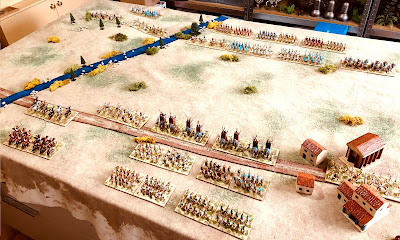When setting up an ancient game I want to use a rule mechanism for determining the setup of the tabletop. Part of my reasoning for doing this is I will be setting up a quick 2nd Punic War campaign in the next couple of months and will need a mechanism for campaign games. This post covers the procedure for setting up terrain on the tabletop.
 |
| A tabletop setup using terrain cards |
For the tabletop setup I am using terrain cards as they proved successful with my English Civil War campaign (see here). The ECW approach uses a deck of hand drawn terrain cards which are shuffled and six are drawn for my 6 x 4 foot tabletop, one for each 2 x 2 foot square area. This is fine for ECW terrain, but with ancient battles fought in more arid regions with few terrain features, a slightly different approach is required.
 |
| Making of terrain cards - 12 cards in all are required. |
The approach I decided upon was to have four blank cards (representing open terrain) which are set aside. Then each player selects two terrain cards a piece from the remaining eight cards. The player's selected cards are added to the blank cards and shuffled. This allows players to select terrain to hopefully suit their army.
 |
| The Carthaginians (top) selected a river and town features. While the Romans (bottom) have selected a large hill and rocky broken terrain features. |
Having shuffled the cards they are laid out in two rows of three to represent my 6 x 4 tabletop. In most cases this will work fine, but there are some additional rules for rivers. Rivers when placed will run North-to-South or East-to-West, depending how they are placed down (no peeking when you are placing them down). When a river's flow is blocked due to hills (they can flow through all other terrain features) they have to be rotated towards another square to avoid the hill. If there are two options, then use the dice to determine direction or allow the player who selected a river to choose the direction.
 |
| Terrain cards are laid out. The flow of the river will need to change due a blocking hill. |
 |
| A river card's direction is adjusted to avoid a hill. |
At the moment I have chosen to go with:
- 4 x open terrain
- 1 x river which is fordable
- 1 x large hill
- 1 x small hill
- 2 x woods
- 2 x broken terrain (fields and rocky terrain)
The approach will on occasion throw up four pieces of terrain, but will for the most part will deliver two or three terrain features. Additional blank cards could be added to the card deck for more arid regions when running a campaign, or reduced for more fertile regions.
 |
| A tabletop with terrain setup to reflect the cards. |
 |
| Terrain setup with armies deployed. |
Next up will be deciding the armies and their deployment.
That's a great, simple and effective system and a really nice looking layout as a result! Can't help feeling that I ( and many others ) will be inspired to 'borrow' these ideas..
ReplyDeleteFeel free to reuse and improve.
DeleteYour table looks super, Peter!
ReplyDeleteThanks. For the most part things have worked out well. Doing things as a project and in one go does help with the consistency of the look and painting style.
DeleteTerrain doesn't seem to affect 2nd Punic battles much other than preventing wide flanking moves at Cannae so I wonder if this is no too much? BTW have you got Phil Sabin's Lost Battles it has some very interesting ideas on how to refight battles during this period - to some extent a similar mechanic where you inflict losses in your turn but take none until the opponents turn.
ReplyDeleteMost rules seem to suggest 2 to 3 terrain features for this period. With any refights of the battle, then as you say few if any terrain features will be present.
DeleteYes, I have and am reading Lost Battles. A most interesting book with lots of ideas for modelling engagement of this period. Thanks.
I like the 'Lost Battles' ability of great commanders to alter the turn sequence so that they get two consecutive turns just once during the game representing some brilliant stratagem / decisive stroke.
DeleteI particularly liked the rule for an all out attack.
DeleteYes very neat idea with the cards determining the terrain!
ReplyDeleteThanks, it seems to work and is simple to use.
DeleteShould've said nice photo of the armies although not sure why some of the Carthaginians are running away before the fight's even got going.
ReplyDeleteOnce I played the game I quickly noticed one unit of Carthaginians was facing the wrong way. I obviously did not have my glasses on when deploying troops.
DeleteI think for ancients particularly, the added mechanic that allows a player to have some influence over the choice of battlefield is a good one.
ReplyDeleteIt is a limited influence, but it is always nice to add where possible into the rules the ability for a player to make a decision to influence the game. Thanks.
DeleteI like your evolution of the terrain cards. Some player selection. A bit more random. Nice.
ReplyDeleteThanks. It seems to be working with the limited terrain pieces. I am currently trying to figure out if it is possible to get a little bit more player influence on the lay out of terrain.
DeleteTerrain is always a bit tough for ancients battles. There usually wasn't much of it (as far as we really know), but what there was was often important, especially if you were facing a Hannibal!
ReplyDeleteI may have to add a couple more blank (open) terrain cards to really minimise the likelihood of terrain features.
Delete